


Soohorang (one of the mascots of Pyeongchang 2018) saying goodbye on the night of the closing ceremony. Photo by Ivan Arias.
The first part of the ICE-POP campaign ended last Sunday when the 2018 Winter Olympic Games were officially finished. However, we will closely monitor the weather and provide information from Pyeongchang during the Paralympics as well. The strong wind that characterized the Olympics has stopped blowing in the last week. This brought unexpected changes in the weather. Also this week was crucial for the campaign since the closing ceremony was scheduled. The ICE-POP team closely monitored the sensors to notice any signature that could help predict any weather that could affect the last days of competition. One of these events occurred on February 23, when D3R Radar from NASA detected unexpected snow coming in. The figure below shows radar reflectivity from D3R for this event after it had developed.

D3R PPI Reflectivity image at Ku frequency band.
Due to the closing of the games, transportation was difficult last week. There were traffic jams and long lines everywhere. It is not an easy task to run a field campaign during a massive event such as the Olympics; it takes a lot of work and logistics. None of this would have been possible without KMA staff, who have coordinated carefully each and every detail of this campaign and have been such wonderful hosts. Many thanks to them. The next picture shows personnel of KMA, NASA, and CSU sharing a cup of coffee while planning some strategies for the campaign.

Photo by Hyejin Lee
Gangneung and Daewallyeong, the cities where the Winter Olympics are taking place, have a unique characteristic for precipitation. The cold and dry front from Siberia converges with the moist air of the Korean East Sea to produce stratiform clouds that occasionally precipitate over the PyeongChang province. This condition where the precipitation comes from the east is difficult for forecasters to predict. When the clouds are formed from the west due to low pressure, prediction is difficult because the ground-based radar’s sensing is limited due to the complex orography. Thus, no matter whether snow comes from east or west, it is always hard for meteorologists to forecast weather it in this area. Nevertheless, snow clouds in the region have a particular characteristic, they normally form around 2 kilometers over the sea level.
On February 13th, the D3R Radar from NASA which is located near PyeongChang captured a low elevation snow formation coming from the west which can be seen in the following images.

On the left is D3R RHI Reflectivity image at Ku frequency band, and on the right is D3R PPI Reflectivity image at Ku frequency band.
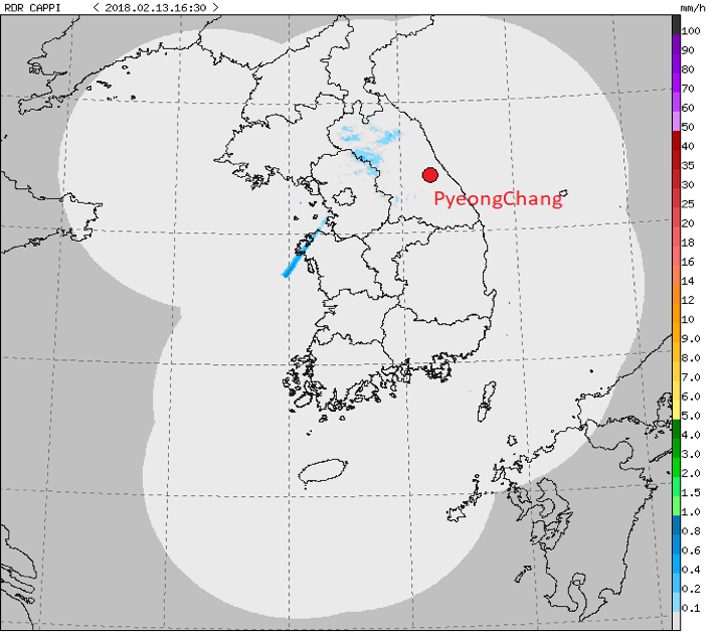
Compound Weather Radar Map of Korea by KMA.
However, no other operational radars from Korea were able to see the snow coming because of the complex relief where outdoor Olympic venues are located. The image below, taken from the KMA website, shows no snow around the PyeongChang region.
The D3R images allowed KMA staff to predict unexpected snow three hours before it started. Television screen captures taken on this day from the NBC Olympics broadcast (below) show snowfall during the cross country classic spring competition.
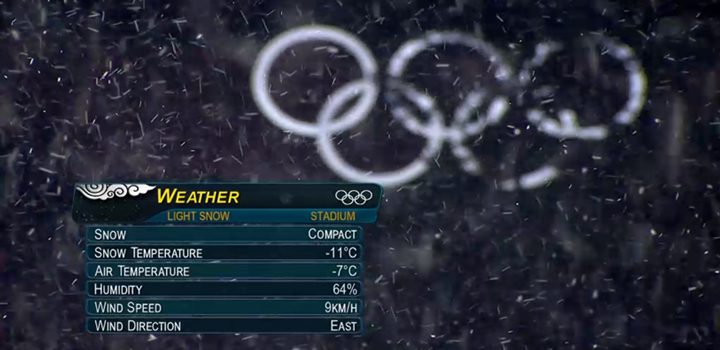
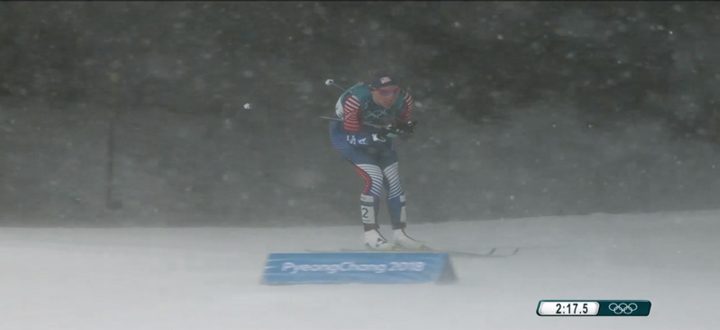
Photos of NBC live streaming the Winter Olympic Games.
International Collaborative Experiments for Pyeongchang 2018 Olympic and Paralympic Winter Games (ICE-POP 2018) is a field campaign that is taking place during the 2018 Winter Olympics held at Pyeongchang, South Korea. It brings state of the art weather sensors from all over the world, and the Dual-frequency Dual-polarized Doppler radar (D3R) from NASA is among them. Around 30 agencies and organizations from 12 different countries are involved in this program including NASA, NOAA, Colorado State University, and the Korea Meteorological Administration (KMA) among others.
Some of the instruments including the D3R are located on the roof of the KMA, Daegwallyeong office as shown in the picture below.
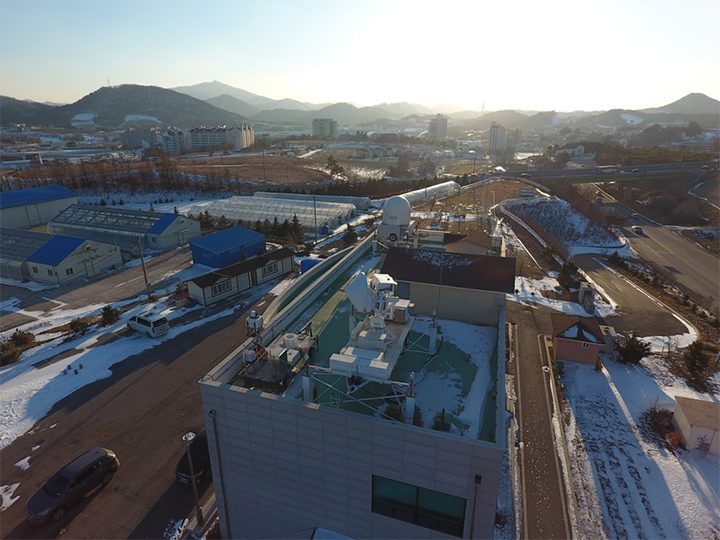
Photo by Aaron Dabrowski.
On the the roof to the left is a scanning wind lidar from Canada. Next to it on the right is NASA’s D3R from United States, in the back is T-Rex UCLM from Spain, and in the far background of the picture a glimpse of Alpensia Olympic Park can be seen. With the main games happening just a few kilometers away, these instruments are useful for making better predictions of the weather.
Around 35,000 people and 16 state leaders attended the 2018 Winter Olympic Games Opening Ceremony. However, what most of them were not aware of is that if a snow storm occurred on the day of event, it would be relocated to an indoor venue since the Pyeongchang Stadium does not have a roof. It was a tough day for the people checking all the ICE-POP instruments and monitoring the weather forecast. The most stressful part was when the radar captured some snow formations 6 hours before the ceremony started. However, close monitoring of the weather dynamics allowed the meteorologists from KMA to predict that no significant snow would reach Pyeongchang, so there was no need to make changes for the ceremony. The below picture shows staff at the KMA Daegwallyeong office during the opening ceremony.
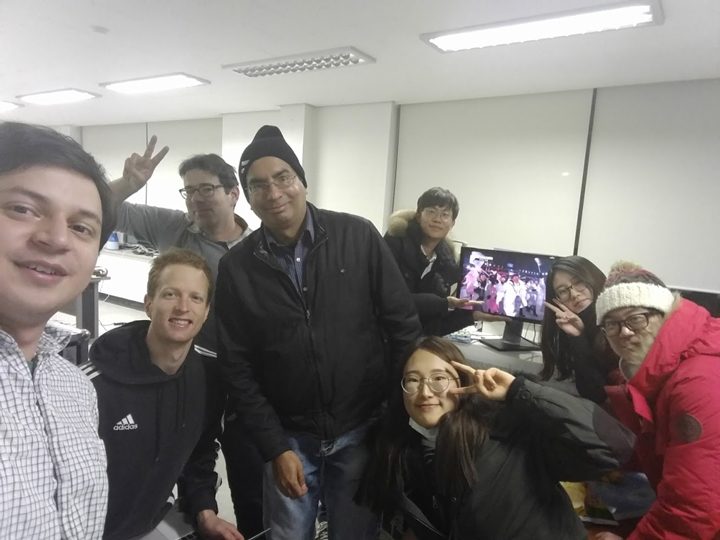
Photo by Ivan Arias.
The ICE-POP group didn’t take their eyes off the sensors the entire night, except to see the fireworks. The below picture shows a view of the opening ceremony fireworks from the KMA Daegwallyeong office.

Photo by Kwonil Kim.